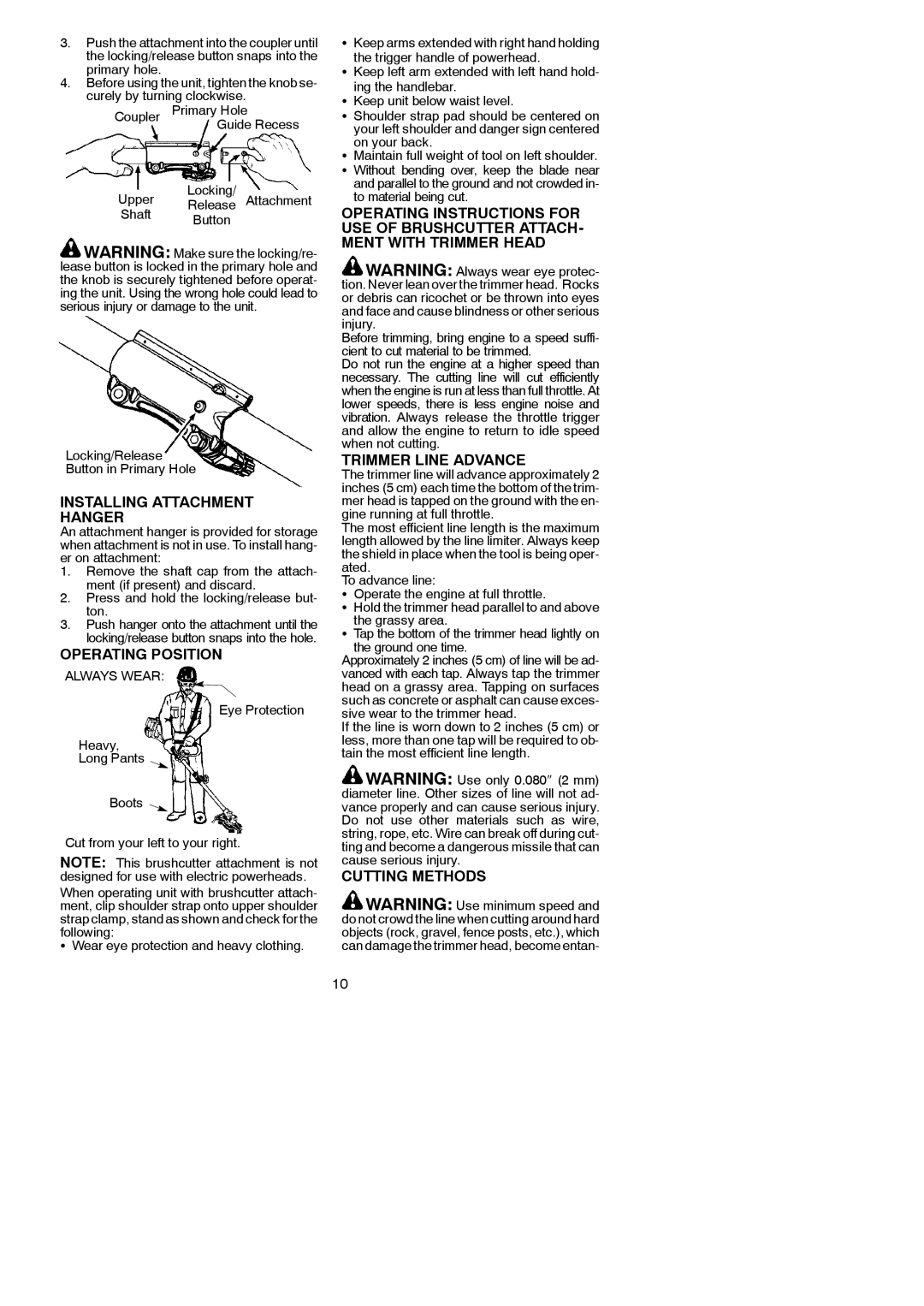
3.Push the attachment into the coupler until the locking/release button snaps into the primary hole.
4.Before using the unit, tighten the knob se- curely by turning clockwise.
Coupler Primary Hole
Guide Recess
Locking/
Upper Release Attachment
Shaft Button
![]() WARNING: Make sure the locking/re- lease button is locked in the primary hole and the knob is securely tightened before operat- ing the unit. Using the wrong hole could lead to serious injury or damage to the unit.
WARNING: Make sure the locking/re- lease button is locked in the primary hole and the knob is securely tightened before operat- ing the unit. Using the wrong hole could lead to serious injury or damage to the unit.
Locking/Release
Button in Primary Hole
INSTALLING ATTACHMENT HANGER
An attachment hanger is provided for storage when attachment is not in use. To install hang- er on attachment:
1.Remove the shaft cap from the attach- ment (if present) and discard.
2.Press and hold the locking/release but- ton.
3.Push hanger onto the attachment until the locking/release button snaps into the hole.
OPERATING POSITION
ALWAYS WEAR:
Eye Protection
Heavy,
Long Pants
Boots
Cut from your left to your right.
NOTE: This brushcutter attachment is not designed for use with electric powerheads.
When operating unit with brushcutter attach- ment, clip shoulder strap onto upper shoulder strap clamp, stand as shown and check for the following:
SWear eye protection and heavy clothing.
SKeep arms extended with right hand holding
the trigger handle of powerhead.
SKeep left arm extended with left hand hold-
ing the handlebar.
SKeep unit below waist level.
SShoulder strap pad should be centered on your left shoulder and danger sign centered on your back.
SMaintain full weight of tool on left shoulder. S Without bending over, keep the blade near and parallel to the ground and not crowded in-
to material being cut.
OPERATING INSTRUCTIONS FOR USE OF BRUSHCUTTER ATTACH- MENT WITH TRIMMER HEAD
![]() WARNING: Always wear eye protec- tion. Never lean over the trimmer head. Rocks or debris can ricochet or be thrown into eyes and face and cause blindness or other serious injury.
WARNING: Always wear eye protec- tion. Never lean over the trimmer head. Rocks or debris can ricochet or be thrown into eyes and face and cause blindness or other serious injury.
Before trimming, bring engine to a speed suffi- cient to cut material to be trimmed.
Do not run the engine at a higher speed than necessary. The cutting line will cut efficiently when the engine is run at less than full throttle. At lower speeds, there is less engine noise and vibration. Always release the throttle trigger and allow the engine to return to idle speed when not cutting.
TRIMMER LINE ADVANCE
The trimmer line will advance approximately 2 inches (5 cm) each time the bottom of the trim- mer head is tapped on the ground with the en- gine running at full throttle.
The most efficient line length is the maximum length allowed by the line limiter. Always keep the shield in place when the tool is being oper- ated.
To advance line:
SOperate the engine at full throttle.
SHold the trimmer head parallel to and above the grassy area.
STap the bottom of the trimmer head lightly on
the ground one time.
Approximately 2 inches (5 cm) of line will be ad- vanced with each tap. Always tap the trimmer head on a grassy area. Tapping on surfaces such as concrete or asphalt can cause exces- sive wear to the trimmer head.
If the line is worn down to 2 inches (5 cm) or less, more than one tap will be required to ob- tain the most efficient line length.
![]() WARNING: Use only 0.080″ (2 mm) diameter line. Other sizes of line will not ad- vance properly and can cause serious injury. Do not use other materials such as wire, string, rope, etc. Wire can break off during cut- ting and become a dangerous missile that can cause serious injury.
WARNING: Use only 0.080″ (2 mm) diameter line. Other sizes of line will not ad- vance properly and can cause serious injury. Do not use other materials such as wire, string, rope, etc. Wire can break off during cut- ting and become a dangerous missile that can cause serious injury.
CUTTING METHODS
![]() WARNING: Use minimum speed and do not crowd the line when cutting around hard objects (rock, gravel, fence posts, etc.), which can damage the trimmer head, become entan-
WARNING: Use minimum speed and do not crowd the line when cutting around hard objects (rock, gravel, fence posts, etc.), which can damage the trimmer head, become entan-
10
